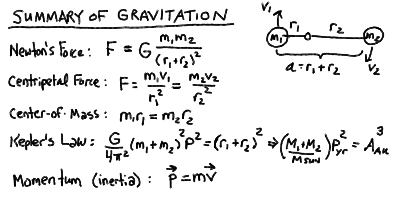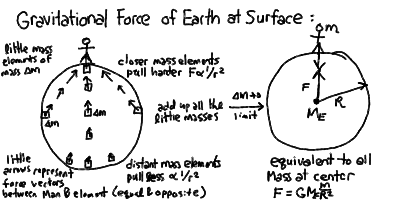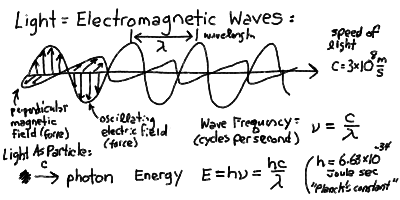Lecture 16 - Gravitation and Light (2/19/96)
Seeds: Chapters 4, 5
- Review of Gravitation
- Newton's Three Laws of Motion: Inertia, F=ma,
and F_12 = -F_21 (reaction).
- Universal Gravitation:
F = G M m / r^2
- Centripetal acceleration:
a = v^2/ r
- Gravitation is universal: a falling apple is subject to the
same laws (and forces) as an orbiting moon or planet! It was
being able to calculate the accelerations of the Moon and planets
that convinced Newton of the correctness of his theory, not just
an apple falling on his head.
- Kepler's 3rd Law: P^2 = a^3 follows from Newtons gravitational force
plus centripetal acceleration to calculate velocity. Newton's
modification to Kepler's law (M + m)P^2 = a^3 takes into account
the masses of both the Sun and planet (or planet and moon). Note
that since it derives from Newton's theory, Kepler's laws are also
universal - they apply not just to the Sun and planets in our solar
system, but to any orbiting bodies, including satellites.
- Center of Mass (or barycenter): Because of Newton's 3rd Law of equal
action and reaction, we know that if the Sun causes the Earth to
orbit, then the Earth causes the Sun to orbit. We can find that
for two isolated bodies in mutual orbit:
m_1 r_1 = m_2 r_2
where
r_1 and r_2 are the distances from the barycenter, or
center of mass, of the system. The two bodies orbit mutually in
similar circular or elliptical orbits such that they remain on
a line through the barycenter with respective distances given by
the above equation and on opposite sides.
- Thus, the relative orbit of the two can be thought of as circular
or an ellipse centered on one of the bodies with a semi-major axis
a = r_1 + r_2. This is the familiar Keplerian orbit.
- Weight vs. Mass: We are used to using the terms weight and mass
interchangeably. In fact, weight refers to the gravitational
force on a body while mass in a measure of the innate
matter content of a body. The mass of an astronaut is the same
on the Moon as on the Earth, but the weight is less on the Moon,
because the gravitational force exerted by the Moon at the surface
is less. In space, an astronaut is "weightless", not massless!
- We can calculate the weight of a body at the surface of the Earth
by adding up the contributions from each individual atom of the
Earth. If we approximate the Earth as a sphere (of radius R)
with us at the surface, and break up the Earth's mass into tiny
cubes, and add up the forces, then take the limit as the little
chunks become infintesimally small, then we find Newton's result
that the gravitational acceleration at the surface is a = GM/R^2
where M is the mass of the Earth. Note that this is the same
as if the entire mass of the Earth were concentrated at the center!
This us a property of a sphere and the force falling as 1/R^2.
- Thus, if we write the weight (force) at the surface as F = mg,
then the acceleration of gravity g at the Earth's surface is given
by g = GM/R^2 = 9.8 m/s^2.
- Although we have done this only for illustrational reasons, I have
shown you how to calculate the centripetal acceleration in an orbit
and the gravitational acceleration at the surface of a sphere by
using "infintesimals" - this is calculus as it was devised
by Newton! We calculated the centripetal acceleration a = v^2/r
by finding the small changes in x and y needed to stay on a circle.
The calculus of changes involve derivatives or differential
calculus. The adding up of tiny mass elements in the sphere is an
example of integration or integral calculus.
- Light and Electromagnetic Waves
- Almost everything we know about the Universe has been brought
to us by the light that we observe with our instruments and
eyes.
- Light, radio waves, radar, X-rays and ultraviolet rays are all
examples of the same phenomenon of electromagnetic radiation.
- Light can be thought of as a electromagnetic wave with
crests and troughs as in ocean waves (but without the ocean!).
The things that are rising and falling in an electromagnetic wave
are the electric and magnetic "fields", which rise and fall in
step as a function of space and time.
- If we were to freeze time, and move along the direction of a wave,
we would measure electric and magnetic forces that increased then
decreased then changed direction and back again, like a sine wave.
The distance between crests of the wave is called the wavelength
and is measured in meters (or centimeters or nanometers, whatever is
convenient).
- If one were to let time move normally, but measure the electric and
magnetic forces as a wave passes by, then we would see the crests
and troughs moving past us at the speed of light. Thus, we would
see the waves pass us at the frequency of a certain number
of cycles per second, say f, given by:
f = c / L
where L is meant to be the wavelength. We are familiar in
using frequency to describe radio waves. When we say our favorite
radio station has a frequency of 100 Megacycles (or MegaHertz), we
mean that f = 100 x 10^6, that is 10^8, cycles per second.
(Remember, mega means 10^6). Note that since the speed of light
c = 3 x 10^8 m/s, that a frequency of 100 megacycles corresponds
to a wavelength L = c/f = 3 meters.
- The electric and magnetic forces in an electromagnetic wave are
at right angles (perpendicular) to each other always.
- Light and Photons
- Light can also be thought of as made up of particles, known as
photons. Light is both a wave and a particle at the same
time. The reconciliation of this dual nature has been one of the
greatest breakthroughs in physics at the turn of the century.
- Each photon has a specific energy given proportional to the
frequency of the wave that it corresponds to. The energy of
a photon of frequency f is:
E = h f
where the constant h is known as Planck's constant.
- Planck's constant h = 6.63 x 10^-34 Joules sec, where the
Joule (J) is the SI unit of energy (1 Joule = 1 kg m^2/ s^2),
and is the energy needed to run a 1 Watt light bulb for 1 second
(1 Watt = 1 Joule/sec) - or a 100 Watt light bulb for 0.01 seconds.
- There are many different energy photons, with energies ranging
from zero to infinity, each corresponding to waves with wavelengths
from infintely long to infintesimally small (zero). This is what
is called the electromagnetic spectrum.
- Radio waves, with wavelengths around 1 meter, are fundamentally the
same as visible light, with wavelength around 500 nanometers (nm),
the same as X-rays, with wavelengths around 1 nm.
- Because the photon energy is proportional to frequency, the high
frequency, short wavelength radiation like UV and X-rays and Gamma
Rays can actually do major damage to our bodies if we are exposed to
it. It takes many microwaves (wavelength about 1 cm) to cook food
in a microwave oven, because the photons each have very low energy.
Nuclear explosions release large amounts of deadly Gamma Rays, each
of which can do lots of molecular damage when they pass into organic
material.
- Different materials absorb specific frequencies of light. This is
due to resonances with atomic and molecular structures as we will
see later on. The air in the Earth's atmosphere absorbs the waves
except special "windows" or wavelength bands where it is transparent.
Both visible light and radio waves fall in these windows, so we can
see out from the Earth into the heavens.
-
Just as electromagnetic waves of light are also particles (photons),
all particles such as electrons and protons are waves! It turns out
that a particle of momentum p has a wavelength of
L = h / p = h / m v
so more massive particles have smaller
wavelenghths. This property is used in electron microscopes,
which act like normal microscopes except using the wave nature of
electrons instead of light. Because the wavelength of an electron
wave is very very small, it can see smaller things than normal light
based microscopes.
Next Lecture -
Optics and Telescopes
Review of Gravitation
A summary of useful formulae we have derived for gravitation:

The weight of an object at the surface of the Earth is just
a measure of the gravitational force exerted on it by the Earth.
You can calculate this force for a sphere, as Newton did, by adding
up all the contributions of small mass elements in the Earth, then
taking the limit as the mass elements become infinitesimal:

Light and Electromagnetic Waves
The electromagnetic wave and photon:

Go to Previous Lecture ----
Go to Next Lecture
Back to the Lecture Notes Index
Back to the Sec3 Page
Steven T. Myers - Last revised 29Feb96



